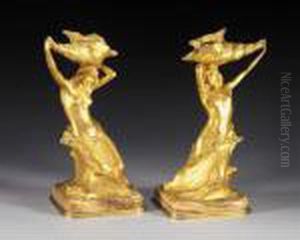Hans Muller Paintings
Hans Müller was an Austrian sculptor born on August 21, 1873, in Vienna. He was known for his detailed and expressive sculptures, many of which were influenced by the Art Nouveau movement that was popular during his time. Müller was educated at the Academy of Fine Arts Vienna, where he studied under renowned artists such as Edmund von Hellmer and August Kühne.
After completing his education, Müller began to make a name for himself in the Viennese art world. His works were often characterized by a sense of realism and a detailed approach to the human form. He was particularly adept at capturing the nuances of facial expressions and the flow of garments in his sculptures. He worked in various mediums, including marble, bronze, and wood, and his subjects ranged from historical figures to allegorical representations.
Müller's career was marked by several notable commissions and exhibitions. He participated in exhibitions at the Vienna Künstlerhaus and was involved in various public and private commissions, which included sculptures for architectural projects and monuments. Despite not being as widely recognized as some of his contemporaries, Müller's work was appreciated for its craftsmanship and contribution to the Viennese sculpture scene of the early 20th century.
Hans Müller's artistic career was also influenced by the political and social changes of his time. The tumultuous period leading up to World War I and the subsequent interwar years had an impact on the themes and reception of his work. Nevertheless, Müller continued to produce sculptures throughout his life, and his pieces can be found in various collections and museums.
Hans Müller passed away on September 15, 1937, in Vienna, leaving behind a body of work that, while perhaps not as widely known as that of some of his peers, demonstrates a high level of skill and a deep understanding of the sculptural form. His contributions to Austrian art are still recognized by art historians and collectors today.
